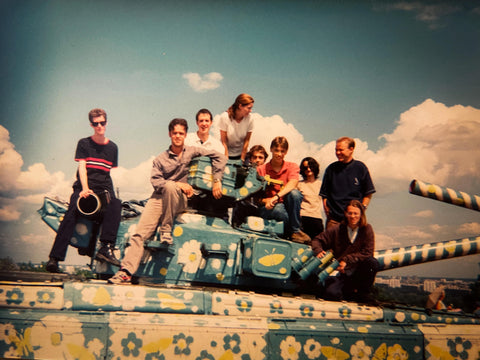Greg McGee in Kyiv, 1997
By Greg McGee

If you were to play word association in 1997 and throw in ‘Kiev’ the response would invariably be ‘Chicken’. As a 21 year old departing for a coach journey to live in Ukraine for 10 months I held similarly dim views of my destination city. I knew that Kyiv (the now preferred spelling) had been a USSR communist city for decades, a fact which held its own dark glitter, but my young man’s antennae had also picked up the sense of a city being born right here, right now. Leaving Spice Girls Britain for a city of possibilities was an easy choice to make.

My first impression was that no one in Kyiv had ever heard of Chicken Kiev. The second was the architecture. USSR planners were not known for their flourish, but the Soviet insistence on sameness was surprisingly offset by huge examples of rococo and detailed facades. Even in the midst of its post World War II makeover, Kyiv had one eye on maintaining some kind of balance, it seemed. Though the Lenin statues stared out from street corners, they felt more like a necessary recognition of recent heritage than potent political symbols. Sumptuously baroque churches, choc full of worshippers now the anti-religious persecutions of the state had abated, stood next to colossal war memorials that made 1998's Angel of the North back home in Tyneside look like an A-Level art installation. Underground metro stations, some of the deepest in the world serving one and a half million daily passengers, displayed in mosaic the timeline of kings and saints from medieval glories. Zoloti Vorota Station hulked hugely, a replica of the giant fortifications which failed to keep out the invading forces of Batu Khan’s Mongols in 1240. Black Mercedes saloons disgorged wannabe mafia men on street corners to buy caffè Americanos.

It was this flinching willingness to fuse its ancient, recent and nascent identities that set Kyiv apart at the end of the century. Cities in the UK were just starting to embrace homogenous anonymity, with the same bookstores, coffee shops, chain pubs, and anti-social stag parties that dilute them to this day. Kyiv was simply up for seeing where the chips fell. The book shop that made me feel so welcome in January was a Drum and Bass nightclub by February; the Mexican Restaurant was a Cocktail Bar by March. Literature was a source of pride, with Kyiv’s Bulgakov’s ‘Master and Margarita’ providing inspiration for The Rolling Stone’s ‘Sympathy for the Devil.’ For 30p each week I watched the staple diet of Operas and Ballets at ‘National Opera of Ukraine’ with local artist Dima and his crew. We had all become friends and we relaxed with Ukrainian beer (Obolon! Soft, rich, grainy) in new bars and clubs afterwards.

There was no denying the groundswell of independence that had gathered momentum since the fall of the Iron Curtain 5 years earlier. There was some nostalgia from some quarters for the rigorous certainties of the Soviet era, but increasingly the vibe over coffee, tea, vodka or McDonalds, was the excitement that came with closer assimilation with Europe, whether that meant becoming part of the EU or NATO. The end of the most complicated century in this country’s see-saw history must surely bring with it the dawn of a new age of calm prosperity, we thought. The Millennium was going to be a big deal for young Kyivites: they had been patient and philosophical, and they were at last due the turn of the wheel that had eluded them so long.

The rest of the article is found here:
https://www.yorkpress.co.uk/news/19892789.york-gallery-owner-greg-mcgee-recalls-life-kiev-1997/
